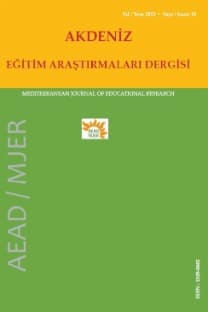İnvestigation of the predictors of anxiety and self‐esteem in a sample of university students
Üniversite öğrencilerinde kaygı ve benlik saygısını etkileyen faktörlerin incelenmesi
___
Adewuya, A. O., Ola, B. A., & Adewumi, T. A. (2007). The 12‐month prevalence of DSM‐IV anxiety among Nigerian secondary school adolescents aged 13‐18 years. Journal of Adolescence, 30(6), 1071‐1076.Antai‐Otong, D. (2008). Social anxiety disorder: Characteristics, course, and pharmacological management prevalence. Perspectives in Psychiatric Care, 44, 48‐53
Arns, P. S., Linney, J. A. (1993). Work, self, and life satisfaction for persons with severe and persistent mental disorders. Psychosocial Rehabilitation Journal, 17, 63‐79.
Beck, A. T., & Steer, R. A. (1990). Manual for the Beck Anxiety Inventory, Psychological Corporation. San Antonio: TX.
Beck, A.T., Epstein, N., Brown, G. & Steer, R.A., (1988). An inventory for measuring clinical anxiety. Journal of Consulting and Clinical Psychology 56, 893–897.
Begley, C. M., & White, P. (2003). Irish nursing students’ changing self‐esteem and fear of negative evaluation during their preregistration programme. Journal of Advanced Nursing, 42(4), 390‐401. Brand, J. A., & Dodd, D. K. (1998). Self‐esteem among college men as a function of Greek affiliation and year in college. Journal of College Student Development, 39(6), 611‐615.
Connell, J.P., Spencer, M.B., & Aber, J.L. (1994). Educational risk and resilience in African‐American youth: Context, self, action and outcomes in school. Child Development, 65, 493‐506.
Davies, J., & Brember, I. (1999a). Boys outperforming girls: An 8‐year cross‐sectional study of attainment and self‐esteem in year 6. Educational Psychology, 19(1), 5‐16.
Davies, J., & Brember, I. (1999b). Self‐esteem and national tests in year 2 and 6: A 4‐year longitudinal study. Educational Psychology, 19(3), 337‐345.
De Beurs, E., Wilson, K. A., Chambless, D. L., Goldstein, A. J., & Feske, U. (1997). Convergent and divergent validity of the Beck Anxiety Inventory for patients with panic disorder and agoraphobia. Depression and Anxiety, 6, 140–146.
Fries, A., Frey, D., & Pongratz, L. J. (1977). Anxiety, self‐esteem and cognitive dissonance. Archiv fur Psychologie, 129(1), 83‐98.
Guvenc, G., & Aktas, V. (2006). Age, gender, prejudice, interpersonal sensitivity and locus of control as predictors of selfesteem, assertiveness and communication skills in adolescence. Turk Psikoloji Dergisi, 21, 45‐62.
Hafen, M., Reisbig, A. M. J., White, M. B., & Rush, B. R. (2006). Predictors of depression and anxiety in first year veterinary students: A preliminary report. Journal of Veterinary Medical Education, 33(3), 432‐440.
Josephs, R. A., Markus, H. R., & Tafarodi, R. W. (1992). Gender and self‐esteem. Journal of Personality and Social Psychology, 63(3), 391‐402.
Kitano, K. (2001). Anxiety in the college japanese language classroom. The Modern Language Journal, 85, 549‐566.
Kling, K. C., Hyde, J. S., Showers, J., & Buswell, B. N. (1999). Gender differences in self‐esteem: A meta‐analysis. Psychological Bulletin, 125(4), 470‐500.
Kocovski, N. L., & Endler, N. S. (2000). Social anxiety, self‐regulation, and fear of negative evaluation. European Journal of Personality, 14(4), 347‐358.
Lane, J., Lane, A. M., Kyprianou, A. (2004). Self‐efficacy, self‐esteem and their impact on academic performance. Social Behavior and Personality, 32(3), 247‐256.
Leary, M. R. (1983). Social anxiousness: The construct and its measurement. Journal of Personality Assessment, 47, 66‐75.
Many, M. A., Many, W. A. (1975). The relationship between self‐esteem and anxiety in grades four through eight. Educational and Psychological Measurement,35(4), 1017‐1021.
Marron, J. A., & Kayson, W. A. (1984). Effects of living status, gender and year in college on college students’ self‐esteem and life change experiences. Psychological Reports, 55(3), 811‐814.
McCarthy, J. D., & Hoge, D. R. (1982). Analysis of age effects in longitudinal studies of adolescent self‐esteem. Developmental Psychology, 18(3), 372‐379.
McMullin, J. A., & Cairney, J. (2004). Self‐esteem and the intersection of age, class and gender. Journal of Aging Studies, 18, 75‐90.
Nurmi, J., Aunola, K., Salmela‐Aro, K., & Lindroos, M. (2003). The role of success expectation and task‐avoidance in academic performance and satisfaction: Three studies on antecedents, consequences and correlates. Contemporary Educational Psychology, 28, 59‐90.
Pajares, F. (1996). Self‐efficacy beliefs in achievement settings. Review of Educational Research, 66, 543‐578.
Pruessner, J. C., Lord, C., Meaney, M., & Lupien, Sonia. (2004). Effects of self‐esteem on age‐related changes in cognition and the regulation of the hypothalamic‐pituitary‐adrenal axis. Rachel, Y., & Bruce, McE. [Eds]; Biobehavioral stress response: Protective and damaging effects. New York, NY: New York Academy of Sciences.
Radovanovic, N., & Glavak, R. (2003). The relationship of fear of negative evaluation with self‐consept and social perception among adolescents. Drustvena Istrazivanja, 12(6), 1123‐1139.
Ranta, K., Kaltiala‐Heino, R., Kiovisto, A. M., Tuomisto, M. T., Pelkonen, M., & Marttunen, M. (2007). Age and gender differences in social anxiety symptoms during adolescence: The Social Phobia Inventory (SPIN) as a measure. Psychiatry Research, 153(3), 261‐270.
Rosenberg, M. (1965). Society and the adolescent self‐image. Princeton, NJ: Princeton University Press. Saville, B. K., & Johnson, K. B. (2007). Year in college and sorority membership in predicting self‐esteem of a sample of college women. Psychological Reports, 101(3), 907‐912.
Silber, E., Tippett, J. S. (1965). Self‐esteem: Clinical assessment and measurement validation. Psychological Reports, 16, 1017‐1071.
Simon, N. M., Zalta, A. K., Worthington, J. J., Hoge, E. A., Christian, K. M., Stevens, J. C., & Pollack, M. H. (2006). Preliminary support for gender differences in response to fluoxetine for generalized anxiety disorder. Depression and Anxiety, 23(6), 373‐376.
Skaalvik, E. M. (1990). Gender differences in general academic self‐esteem and in success expectations on defined academic problems. Journal of Educational Psychology, 82(3), 593‐598.
Teachman, B. A., & Allen, J. P. (2007). Development of social anxiety: Social interaction predictors of implicit and explicit fear of negative evaluation. Journal of Abnormal Child Psychology, 35, 63‐78.
- ISSN: 1309-0682
- Yayın Aralığı: 4
- Başlangıç: 2008
- Yayıncı: Tayfun Taşbilek
İnvestigation of the predictors of anxiety and self‐esteem in a sample of university students
İlköğretim üçüncü sınıf kız ve erkek öğrencilerin oyunlarındaki konuşmaların cinsiyete göre analizi
Öğretmenlerin sınıf yönetiminin düzen oluşturma boyutuna ilişkin uygulamaları
Ali E. ŞAHİN, Özge ERDODOĞAN, Şükran UÇUŞ, Nilgün BAKKALOĞLU
